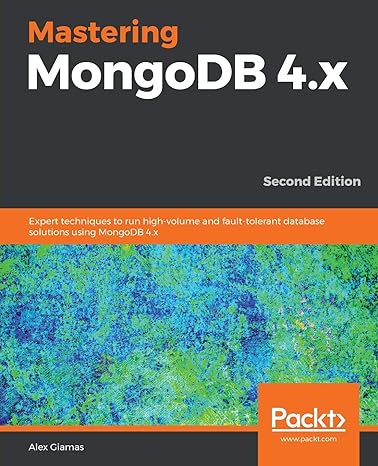Question
I need a High level Diagram for the architecture of the project and Detailed explanation of the algorithms/pre-trained models that you have used and construct
I need a High level Diagram for the architecture of the project and Detailed explanation of the algorithms/pre-trained models that you have used and construct a diagram for each one of them.:
import os import zipfile
# Download the CelebA dataset !wget -O celeba.zip https://www.dropbox.com/s/d1kjpkqklf0uw77/celeba.zip?dl=1
# Extract the images with zipfile.ZipFile("celeba.zip", "r") as zip_ref: zip_ref.extractall("celeba")
import numpy as np import pandas as pd from PIL import Image
# Load the attribute labels attributes = pd.read_csv("celeba/list_attr_celeba.csv")
# Select only the "Image_ID" and "Smiling" columns attributes = attributes[["Image_ID", "Smiling"]]
# Convert the "Smiling" column to a boolean attributes["Smiling"] = (attributes["Smiling"] == 1)
# Create an empty list to store the images images = []
# Load the images and resize them to 128x128 for i, row in attributes.iterrows(): image_id = row["Image_ID"] image = Image.open(f"celeba/{image_id}") image = image.resize((128, 128)) image = np.array(image) images.append(image)
# Convert the images to a numpy array images = np.array(images)
# Split the images into a training set and a validation set train_images = images[:100000] val_images = images[100000:]
# Split the attribute labels into a training set and a validation set train_attributes = attributes[:100000] val_attributes = attributes[100000:]
import tensorflow as tf import tensorflow_gan as tfgan
# Load the dataset (train_images, train_attributes), (val_images, val_attributes) = load_celeba_dataset(num_images=100000)
# Create the generator and discriminator models generator = tf.keras.Sequential([ tf.keras.layers.InputLayer(input_shape=(128, 128, 3)), tf.keras.layers.Conv2D(filters=64, kernel_size=3, strides=1, padding="same", activation="relu"), tf.keras.layers.Conv2D(filters=128, kernel_size=3, strides=2, padding="same", activation="relu"), tf.keras.layers.Conv2D(filters=256, kernel_size=3, strides=2, padding="same", activation="relu"), tf.keras.layers.Conv2D(filters=512, kernel_size=3, strides=2, padding="same", activation="relu"), tf.keras.layers.Conv2DTranspose(filters=256, kernel_size=3, strides=2, padding="same", activation="relu"), tf.keras.layers.Conv2DTranspose(filters=128, kernel_size=3, strides=2, padding="same", activation="relu"), tf.keras.layers.Conv2DTranspose(filters=64, kernel_size=3, strides=2, padding="same", activation="relu"), tf.keras.layers.Conv2DTranspose(filters=3, kernel_size=3, strides=1, padding="same", activation="tanh"), ])
discriminator = tf.keras.Sequential([ tf.keras.layers.InputLayer(input_shape=(128, 128, 3)), tf.keras.layers.Conv2D(filters=64, kernel_size=3, strides=2, padding="same", activation="relu"), tf.keras.layers.Dropout(0.5), tf.keras.layers.Conv2D(filters=128, kernel_size=3, strides=2, padding="same", activation="relu"), tf.keras.layers.Dropout(0.5), tf.keras.layers.Conv2D(filters=256, kernel_size=3, strides=2, padding="same", activation="relu"), tf.keras.layers.Dropout(0.5), tf.keras.layers.Conv2D(filters=512, kernel_size=3, strides=2, padding="same", activation="relu"), tf.keras.layers.Dropout(0.5), tf.keras.layers.Flatten(), tf.keras.layers.Dense(1, activation="sigmoid"), ])
# Compile the generator model generator.compile(optimizer=tf.keras.optimizers.Adam(learning_rate=2e-4, beta_1=0.5), loss="binary_crossentropy")
# Compile the discriminator model discriminator.compile(optimizer=tf.keras.optimizers.Adam(learning_rate=2e-4, beta_1=0.5), loss="binary_crossentropy", metrics=["accuracy"])
# Create the GAN model gan = tfgan.gan_model(generator, discriminator) gan.compile(optimizer=tf.keras.optimizers.Adam(learning_rate=2e-4, beta_1=0.5), loss="binary_crossentropy")
# Train the GAN model gan.fit(train_images, epochs=20, batch_size=64, validation_data=(val_images, val_attributes))
Step by Step Solution
There are 3 Steps involved in it
Step: 1

Get Instant Access to Expert-Tailored Solutions
See step-by-step solutions with expert insights and AI powered tools for academic success
Step: 2

Step: 3

Ace Your Homework with AI
Get the answers you need in no time with our AI-driven, step-by-step assistance
Get Started


